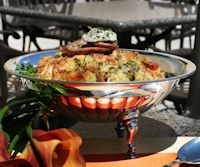This is part a monthly series about the food of the N.C. coast. Our Coast’s Food is about the culinary traditions and history of N.C. coast. The series covers the history of the region’s food, profiles the people who grow it and cook it, offers cooking tips — how hot should the oil be to fry fish? — and passes along some of our favorite recipes. Send along any ideas for stories you would like us to do or regional recipes you’d like to share. If there’s a story behind the recipe, we’d love to hear it.
Oyster DressingThis old-fashioned N.C. recipe is based on one Wanchese cook Nora Scarborough contributed to Coastal Carolina Cooking by Nancy Davis and Kathy Hart. The 1986 book published by the University of North Carolina press contains recipes from native coastal North Carolinians. While cooks in other states suggest using cornbread, fresh parsley and cream in the mix, North Carolinians tend to not like anything that overwhelms the flavor of seafood. Scarborough suggested stuffing the mixture inside the turkey and adding cooked giblets, if desired. If any of the mixture was leftover, Scarborough cooked it in its own baking dish.
In a mixing bowl, gently combine all ingredients. Place in a buttered pan and bake at 350 degrees for about 30 minutes or until heated through. |
Hardly a cook on the N.C. coast gets through the Thanksgiving season without thinking about oyster stuffing.
Supporter Spotlight
The name itself evokes visions of plump oysters hidden in a fluffy blend of herbs, breadcrumbs and rich stock, a dish so luxurious it begs a silver dish rather than a place inside the holiday turkey.
Oyster stuffing is a Southern dish that sounds American. Pilgrims found oysters up to a foot long when they landed in the New World. Alas, nothing about Thanksgiving traditions seem to match true history, as is the case with oyster stuffing.
 “While Native Americans may have combined oysters with grains and herbs we do not find evidence they used this combination to stuff fowl. Classic American oyster stuffing appears to have been a gift from our European forefathers,” according toThe Food Timeline.
“While Native Americans may have combined oysters with grains and herbs we do not find evidence they used this combination to stuff fowl. Classic American oyster stuffing appears to have been a gift from our European forefathers,” according toThe Food Timeline.
“Culinary evidence suggests the French originated oyster dressings in conjunction with modern cuisine (17th century). This practice was adopted by the English and neighboring countries.”
By the 1700s, American cookbooks offered oyster stuffing recipes, the oldest of which were printed in the southern colonies. These days, oyster stuffing is most common in Cajun and Creole cuisine, where oysters are plentiful and much loved, but with so many oysters along America’s East Coast, the recipe found fans far north, too.
Supporter Spotlight
A recipe for “Roast Turkey” in the Boston Cooking School Cook Book that Mrs. D.A. Lincoln wrote in the 1800s directs cooks to add oysters to a stuffing of “soft bread or cracker crumbs highly seasoned with sage, thyme, salt and pepper” and moistened with melted butter, a little water and an egg.
Chopped salt pork is an option, Lincoln noted, but “stuffing is more wholesome without it,” she advised.
Her point is worth consideration. Surprising to diners who try oyster stuffing for the first time is how little flavor and texture the shellfish might provide. Their delicate taste and texture may get lost in the bread and, if stuffed into the turkey, overwhelmed by the bird’s flavor.
That’s not to say oyster stuffing is not due to the lovely oysters that go into it. If placed inside the turkey, the dish is called “stuffing.” If baked in a pan all its own, the recipe is called “dressing,” perhaps a better choice for this elegant dish. Plenty of oysters and their juices given a gentle turn into plain crushed crackers is a special treat never, of course, to be drowned in gravy.







